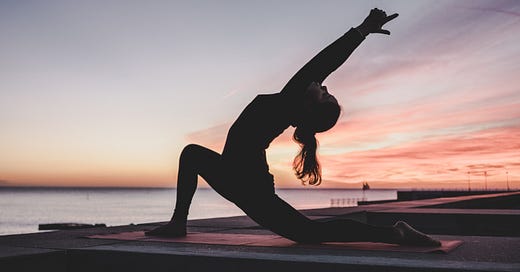Yoga is not Exercise
What is the difference between vyaayama and exercise and yoga? Exercise focuses on the movement of the body, emphasizing aerobic exercises to burn fat, exercises to build resistance and thus increase muscle strength, and exercises for flexibility. Physical therapists move the muscles, and trainers mimic the movements that should be done. Famously discussed by Olympic gymnast Simone Biles recently as ‘twisties,’ the disconnection between the body and the mind leads to disorientation and increased risk for injury.
Yoga is specifically different from exercise because its purpose is not to move the body and burn fat or build resistance. The purpose of yoga is to YOKE the body to the mind, and the mind with the soul, creating a respectful interdependence of the body listening to the instructions of the mind, and the mind listening to the feedback of the body.
Vyaayama is different from yoga and exercise in its emphasis on movements that specifically bring 1) stability and 2) strength to the physical body. Rooted in ayurveda, the definition’s perspective is medical, using movement to optimize and regulate the physiology, especially to stimulates good digestion and to produces resistance to discomforts.
Vyaayama routines recognize the integrated view of Ayurveda, which prioritizes attention to living in a healthy body-mind. Movement of the body regularly balances pitta and kapha and prevents those diseases of metabolism and lubrication. Movement that is coordinated, graceful and flowing also rebalances vāta, though too much aerobic exercise can aggravate vata too. Modern concepts of exercise do not personalize the exercise routine daily based on the current doshas affecting the body. They do not emphasize the importance of coordination, symmetry, grace and flow, but rather focus on speed, power, and raw strength, even when the body is sending warnings.
Exercise is known to increase the size of the hippocampus, the brain structure responsible for memory. Psychological tests for memory show significant improvement after exercise, possibly due to increased circulation and oxygen delivery to the brain, and possibly due to improved mood. Exercise also improves neuroplasticity, the ability of brain cells to regenerate and alter cell functions in line with the needs of the body.
Neuroplasticity was considered impossible by scientists until recently, and claims in ayurveda of regeneration using hair oil treatments and pancakarma were taunted. Today, studies are needed to contrast exercise routines with specific vyaayama routines to show the importance of flow and coordinated symmetric movement in building long-term stability and strength in the physical body. A separate routine of yoga for yoking the mind and body is separate from vyaayama, but can be sequential.
When constructing your daily movement routine, ensure it includes all three subtypes of exercise but also choose sequences that build stability using the body’s inherent programming for symmetry (vyaayama) and the mind’s control over the body (yoga) to avoid “twisties.”
Aerobic exercise is movement that uses oxygen and lung power. It usually gets the cardiopulmonary system moving and is known to burn calories and fat. Running in nature or an aerobic dance routine provide a level of coordination, connection, and improvement of lung capacity.
Resistance training is exercise that stresses the muscles, forcing work against resistance of weight to build muscle volume and increase strength. Instead of weight each day, volunteer to help build a house, or transfer supplies for refugees from truck to storage, or help an elderly neighbor with yardwork, shoveling snow, or cleaning heavy items out of the garage. Coordination of the heart, mind, and muscles provides added benefit to resistance exercises.
Flexibility exercises stretch the muscles, tendons, ligaments and their attachments so that the body has greater range of motion, is more supple and therefore, is less prone to tears and fractures. Partnered warm-downs or intimacy with a beloved partner are wonderful ways to stretch muscles, open the rotator cuff, hip joints and stretch the body. Open-hearted, stable and strong movements during sex make flexibility easy and yoke the joints, tendons and muscles to the heart, mind, and senses.
Disconnection between the body, mind and muscles leads to disorientation and increased risk for injury. Rather than normalizing the “twisties,” we can use the tools of vyaayama which address physical, emotional and mental health, to ensure the integrated whole body stays connected and remains stable and strong.
week 78. TheSouthAsianTimes
Download the .pdf version of this column by clicking on the image.
Dr. Bhaswati Bhattacharya is a Fulbright Specialist 2018‐2023 in Public Health. She serves as Clinical Asst Professor of Family Medicine in the Department of Medicine at Weill Cornell Medical College in New York, NY.
Her bestselling book Everyday Ayurveda is published by Penguin Random House. To order an autographed copy, write to bhaswati@post.harvard.edu.





